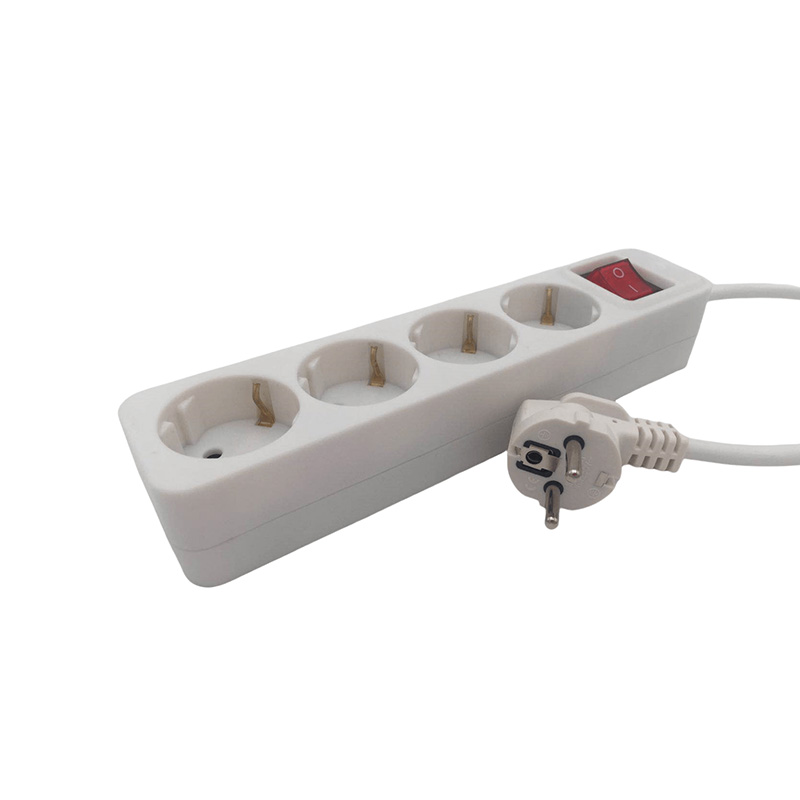Submit feedback
How does the insulation performance of pp material power strip ensure safety during use?
 2025.04.22
2025.04.22
 Industry News
Industry News
The insulation performance of PP material power strip plays a vital role in ensuring safety during use. Polypropylene (PP), as the material of the power strip shell, has certain insulation properties, which allows it to provide electrical safety while effectively preventing safety hazards such as electric shock and short circuit. The following are several key factors for PP material power strips in ensuring safety:
1. Basic insulation properties of polypropylene
Polypropylene (PP) itself is a good electrical insulating material. It has strong electrical insulation, which means that it can effectively prevent current from passing through the material itself and avoid electrical components from contacting the outside world to cause electric shock or leakage. The resistivity of polypropylene is very high and basically non-conductive, which allows it to provide effective isolation and protection for power lines when used as a shell material in power strips.
Resistivity: The resistivity of PP is usually between 10^16 and 10^18 ohm cm, which allows it to withstand higher voltages without being broken down.
Electrical insulation: PP material can effectively isolate electrical components from the external environment and reduce the risk of electric shock.
2. Voltage resistance
PP material has good voltage resistance and can withstand voltage within a certain range without breakdown. The specific voltage resistance level depends on factors such as material quality, thickness and surface treatment. Most PP power strip shell designs can usually meet the common voltage requirements in home and office environments, ensuring safety during use.
High voltage resistance: For common 220V or 110V voltages, PP shells can effectively avoid electrical accidents caused by excessive voltage.
Arc resistance: PP material has a certain arc resistance, which can reduce the risk of electrical fire or equipment damage in the case of short circuit or arc discharge.
3. Prevent external electric shock risk
PP shell design can completely cover the electrical components inside the power strip to prevent users or other personnel from directly contacting the high-voltage electrical parts. The shell is usually rigorously tested to ensure that under normal use conditions, the shell will not break, leak or other safety issues.
Protection level: PP power strips are usually designed to meet certain IP protection levels (such as IP20, IP44, etc.) to ensure that the shell will not be damaged when used in general environments, protecting electrical components from dust, moisture or external pressure.
Anti-electric shock design: Many PP power strips are equipped with additional anti-electric shock designs, such as protective devices in the socket holes, to ensure that conductive parts are not exposed even when the plug is not fully inserted.

4. Heat resistance
During the use of electrical equipment, especially under high power loads, a lot of heat may be generated. If the shell material of the power strip has poor high temperature resistance, it may cause the material to deform and damage, thereby increasing the risk of electrical failure and fire. PP material has good high temperature resistance and can withstand certain temperature fluctuations to avoid dangers caused by excessive temperature.
High temperature resistance: Polypropylene has a high melting point, usually around 160°C, and will not deform or soften due to excessive temperature under normal use conditions.
Heat aging resistance: PP material can resist a certain degree of heat aging, extend service life, and maintain good insulation.
5. Chemical corrosion resistance
In some special working environments (such as humidity, chemical contact, etc.), power strips may be exposed to corrosive substances. PP material has good chemical corrosion resistance, which can effectively prevent corrosive gases or liquids from entering the inside of the power strip, thereby reducing corrosion damage and failure of electrical components.
Corrosion resistance: Polypropylene has good corrosion resistance to acids, alkalis, salt solutions, etc., and can maintain the integrity of the shell in harsh environments.
Water resistance: PP material has good waterproofness, which can maintain electrical safety in humid environments and reduce the risk of short circuits or electrical failures.
6. UL certification and international electrical safety standards
In order to ensure the safety of PP material power strips, many power strip products will pass UL certification or other international electrical safety standards certification. These certifications ensure that the product meets strict electrical safety requirements during design and use, including voltage resistance, insulation, arc resistance, etc.
Compliance with standards: PP material power strips that pass these certifications will undergo rigorous testing to ensure that they will not have electrical failures in high current, high voltage and other environments.
Safety logo: Certified products usually have safety logos, and consumers can choose power strips that meet the standards based on these logos.
The insulation performance of PP power strips ensures the safety of the power strips through the high resistivity of the material itself, good voltage resistance, excellent temperature resistance and chemical corrosion resistance. During the design, by fully considering factors such as electrical insulation, high temperature resistance and corrosion resistance, it can effectively prevent safety hazards such as electric shock and short circuit, and provide users with reliable electrical protection. In addition, PP power strips that meet international electrical safety standards can further improve safety during use.
 TOP
TOP
 ENG
ENG
 English
English русский
русский 한국어
한국어 Deutsch
Deutsch









